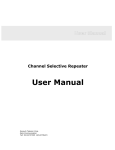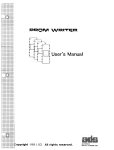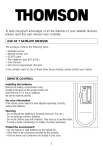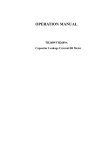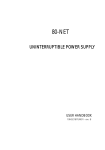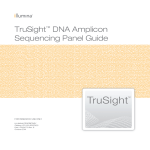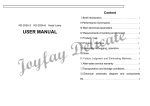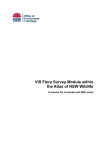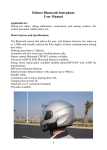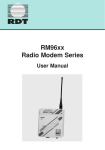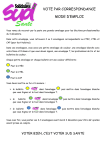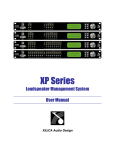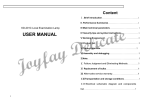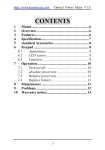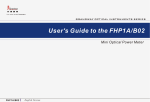Download User Manual
Transcript
Adjustable Band Selective Repeater User Manual SoroushTelecom Corp. Data Communication Tell: 02122737305 02122736415 Adjustable Band Selective Repeater 1 General 1.1 Overview In GSM mobile communication system, limited by the coverage of base station or by geographic environment, the transmission of signals may be influenced in shadow or semi-shadow in some areas, generally referred to as blind area or semi-blind area, bringing serious impact on voice quality or even causing failure to normal communication. To solve this problem, apart from adding more base stations, the deployment of mobile communication repeater, characterized by quick expansion of coverage and reduction of cost, shall be an ideal cost-effective choice of high efficiency. Wireless transmission repeater of GSM mobile communications is an important tool to expand network coverage, enhance network capacity, reduce network cost and realize network optimization. Wireless transmission repeater of GSM mobile communications is meant to amplify communication signal, extend network coverage, to improve communication quality by amplifying some weak received signal and expanding the signal coverage and to distribute traffic load in various base stations with efficiency. In the course of GSM network optimization, wireless transmission repeater of GSM mobile communications offers a wide variety of application, and has become an indispensable part of network system. In some areas, such as satellite cities of some large cities, remote residential areas, countries and towns or other blind areas or shadow areas formed due to the natural or human obstacles (such as high mountains, large buildings, tunnels or underground stores), optical fiber transmission repeater of GSM mobile communications shall be the most economical and reasonable solution to the effective coverage of these Adjustable Band Selective Repeater networks since these areas are demanding a greater coverage rather than capacity. Wireless transmission repeater of GSM mobile communications is cheap with easy installation. It will greatly reduce the investment in equipment and running cost to expand the network by optical fiber transmission repeater. The outdoor cabinet design enables the equipment to work under severe conditions in the open air and saves a lot of operating cost by working without establishment of machine room, air conditioner or large-scale power supply. PULSE GX** wireless communication transmission repeater integrated with wireless technology and excellent performances, provides operators with multiple solutions that can save the investment in equipment and running maintenance cost without lowering the network quality. As a supplement to base stations, the system can be easily expanded to the blind areas that need covering to solve the problem of coverage. By using PULSE GSM repeater of GSM mobile communications, the surplus capacity of networks can be re-planned or re-arranged so that the resources of networks will be used to their maximum. The application of repeater shall attract more traffic load with its short cycles, immediate returned profits, easy installation and savings of network resources and expand the network coverage with low cost to make up for the insufficient coverage of system base station. It is a good solution to optimize network with wireless transmission repeater in networks. Adjustable Band Selective Repeater 1.2 Scope of Application of the Equipment Applicable to airport, stations, highway, railway lines, subway, light rail, tourist areas, large-scale industry and mining enterprises, satellite cities of large cities, remote residential areas, countryside and blind areas and shadow areas of GSM mobile communications. PULSE GX** repeater of GSM mobile communications mainly serves the operators of GSM900MHz mobile communication 1.3 Features (1) Use filter with high selectivity and low insertion-loss and multi-grade filter technology to enhance the isolation between uplink and downlink. (2) No interference to the base station and other radio equipments with low noise for the system, proper linearity and high power. (3) Ensure normal working of the repeater under tough environment with automatic level control (ALC) function. (4) Modularized design facilitates assembly and maintenance. (5) With local LCD or local PC, technicians can monitor, set, modify the parameters of all the modules of repeaters and easily collect equipment information. (6) With wireless digital transmission and remote monitoring system, operator can monitor and maintenance for network more easily. (7) Equipped with perfect network management system (NMS) and friendly operation interface, provide highly reliable operation and failure treatment capability. (8) With Hwatel NMS software, technicians can control repeaters in the monitoring center or optimize parameters and upgrade software according to the actual situation of network. It will facilitate the monitoring of wireless transmission repeater of mobile communications. Adjustable Band Selective Repeater When monitoring center has not been established, technicians can monitor, set, modify the parameters of all the modules of repeaters and easily collect equipment warning information via local PC. Once the repeater fails, monitoring system can immediately send warning information to designated mobile phone or cable phones at will. When a monitoring center has been established, technicians can control repeaters by OMT software in the monitoring center or optimize parameters and upgrade software according to the actual situation of network. It will facilitate the monitoring of wireless transmission repeater of mobile communications. 1.4 Technical standard 1. GSM 05.05 “Wireless transmission and reception 2. GSM 03.30 “Wireless network planning” 3. GSM 11.20 “GSM base station (BBS) equipment specifications” 4. Requirements for repeater by National Radio Administration Bureau 5. YD/T952-1998 “ Technical Requirements for 900M Repeater” Adjustable Band Selective Repeater 2 Technical specification 2.1.1 Major blocks diagram Components of repeater The equipment consists of duplexers, uplink filters, downlink filters, uplink band selective amplifying module, downlink band selective amplifying module, monitoring elements and power elements. 2.1.2 Theory of Operation The downlink signal received by the donor antenna of the base station shall be sent to a band selective filter via duplexer to be filtered and to be amplified by the downlink band selective amplifier to a proper level. The coverage antenna via a duplexer shall emit the downlink signal. Similarly, for uplink, the signal received by the re-transmission antenna shall have its level adjusted to a regulated level by a uplink band selective amplifier after it is filtered. The donor antenna will emit it after it is filtered and sent to the duplexer. Adjustable Band Selective Repeater 2.2 Technical Specification Item Up Link Down Link Frequency range 890-915MHz 935-960MHz Max. Output Power 33dBm 33/37/40/43 dBm Max. Gain 90±3 dB 95±3 dB Gain step 1 db Gain adjust scope 31 dB Adjustable ( Each Step Band width 25 K) ALC 0f <=2 dB f0<=2 dB Passband Ripple No bigger 3 dB No bigger 3 dB Frequency Error ±5X10-8 ±5X10-8 Gain Adjustment Range No less 30dB No less 30dB Gain -10 dB ±1.0dB Adjustmen -20 dB ±1.0dB t Error -30 dB ±1.5dB Gain Adjustment Step 1 dB / Step 1 dB / Step Noise Figure <=4 dB <=4 dB Spurious emission Third-order In Work band inter-modu Out band (offset lation from work band distortion edge 1MHZ) 9KHz-1GHz: <=-36dBm/30KHz 1GHz-12.75GHz: <=-30dBm/30KHz <=-45dBc/30KHz 9KHz-1GHz: <=-36dBm/30KHz 1-12.75GHz: <=-30dBm/30KHz System Time Delay < 5 us VSWR < 1.4:1 In/Output Impedance (Ω) 50W In/Output Connector N-F Working Voltage -48V DC or 220V AC <=-50dBc/30KHz Adjustable Band Selective Repeater Requirement for technical safety Requirement In accordance with relevant regulations in the standard of GB4793-84 for electromagnetic compatibility In accordance with relevant regulations in the standard of GB6833-87 Temperature: -25 ˚c ~ 55˚c Humidity: ≤95% Air pressure: 70~ 106kPa Dimension(W x D x H) 360 x 168 x 420mm LCD and keyboard on Front panel Management and control Local computer through RS232 Remote management via GSM SMS channel * detail tech parameter should reference to Test Report accomplished with its repeater Environmental Conditions Adjustable Band Selective Repeater 3 Installation 3.1 System description Fix part Heat sink Adjustable Band Selective Repeater 3.1.1 Structure and Internal module 3.1.1.1 Power Amplifier 3.1.1.2 LNA Module 3.1.1.3 Filter 3.1.1.4 Duplexer 3.1.1.5 Channel/Band/Frequency Selective 3.1.1.6 GSM Modem 3.1.1.7 Control Unit 3.1.1.8 LCD Panel Adjustable Band Selective Repeater 3.1.2 Bottom panel battery MODEM Antenna BS MS AC220V GND Power Supply Donor Antenna Coverage Antenna Ground 3.1.3 Front panel LCD Alarm ON OFF GSM900 RF REPEATERS POWER Power Reset Enter Shift RS232 :Up : Down Control Key : Right Adjustable Band Selective Repeater 3.2 LCD setting LCD Explain Power On display Power On Welcome PULSE GX ** RF Repeaters Self test: A/D1 ----- passed Test A/D1.. OK Self test: Modem ---- passed, if failure will show “Fail” Test MODEM .. OK LOOK DV_27.0V UPP_28dBm P1.0 -> DNP_37dBm Show status: DV_27.0V:DC power voltage is 27V UPP_28dBm: Uplink Power now is 28 dBm, (range : 0dBm---33dBm) DNP_37dBm: Downlink Power now is 37 dBm,: (range : 0dBm---43dBm) If there alarm , will display at below, such as “DV WRONG” etc … Press “Down” keyboard will show below LOOK AC_220V UPGP_090dB P1.1 -> I_02.0A DNGP_095dB Item 1.1:Show status: AC_220V: current AC power voltage is 220 Volt I_02.0A: current AC power current is 2.0 ampere UPGP_090dB: current uplink gain is 90 dB DNGP _095dB: current downlink gain is 95 dB Press “Down” keyboard will show below menu Adjustable Band Selective Repeater <SETUP SETUP -> LOOK VER P0 -> MENU: SETUP: setup device parameter LOOK: display device parameter VER: display device version When cursor on “VER”, press “Return” button, will show software version as below Version information: PULSE GX** VER1.0 PULSE GX** VER1.0 When cursor on “SETUP”, press “Return” button, will enter setting page and show below When cursor on “LOOK”, press “Return” button, will enter looking page, looking page is same with setting page, only different is can just look and can nor modify any parameter Password setting: operator can edit password through “right” and “shift” button; when finished edit press “return” to confirm KEY_0000: password now is 0000, Default factory password is 0000 KEY_ 0000 <SETUP P2.1 VER_2 FAC_ 0000 FIX_41 COM_2 VER_2 -> <SETUP ID _ 00000000 SN _ FF -> P2.2 <SETUP P2.3 -> CTel _ _ _ _ _ _ _ _ _ _ _ _ JTel _ _ _ _ _ _ _ _ _ _ _ _ Item 2.1:Parameter setting: operator can edit through “right” and “shift” button; when finished edit press “return” to confirm VER_2: setting Version FAC_0000: setting manufactory ID FIX_41: setting device type ID COM_2: setting management mode; Remote mode: ”2”;Local mode: ”5” Item 2.2:Parameter setting: operator can edit through “right” and “shift” button; when finished edit press “return” to confirm ID_00000000: Setting repeater ID , 8 character SN_FF: setting device serial ID Item 2.3:Parameter setting: operator can edit through “right” and “shift” button; when finished edit press “return” to confirm CTel________: Setting NMS center Mobile phone number JTel________: Setting Alarm report Mobile phone number Adjustable Band Selective Repeater <SETUP P2.4 -> CH1 _ ON CH2 _ ON CH3 _ OFF CH4 _ OFF CH5 _ OFF CH6 _ OFF <SETUP P2.5 -> DVL_ON L1G_OFF LNA1 _ ON LNA2_OFF GL _ ON DOOR_ON <SETUP P2.6 -> UPP_ON DNP_ON TCH_ON DLP_ON <SETUP UPSW _OFF CS_OFF P2.7 DNSW_ON POWER_ON <SETUP UHPA_ 0 UATT_ 00dB UPH--+05dBm P2.8 -> DHPA-1 DATT_ 00dB DPH--+36dBm <SETUP P2.9 -> CH1_ 055 CH2_ 050 CH3_ 065 CH4_ 060 Item 2.4: work channel enable setting: operator can edit through “right” and “shift” button; when finished edit press “return” to confirm CH1_ON: 1st work channel open CH2_ON: 2nd work channel open CH5~CH8: no use Item 2.5: Alarm Enable setting: operator can edit through “right” and “shift” button; when finished edit press “return” to confirm DVL_ON: Loss power alarm Enable L1G_OFF: Fiber Optical alarm Enable (for GV900F-OW family) LNA1_ON: uplink LNA failure Enable LNA2_ON: downlink LNA failure Enable GL_ON: self active alarm Enable DOOR_ON: door open alarm Enable Item 2.6: Indicator Enable setting: operator can edit through “right” and “shift” button; when finished edit press “return” to confirm UPP_ON: uplink power overload Indicator enable DNP_ON: downlink power overload enable TCH_ON: temperature alarm Enable DLP-ON: downlink input power threshold enable Item 2.7: Alarm Enable setting: operator can edit through “right” and “shift” button; when finished edit press “return” to confirm UPSW_ON: uplink stationary wave alarm enable DNSW_ON: downlink stationary wave alarm enable POWER_ON: power modular failure alarm enable Item 2.8: Alarm Enable setting: operator can edit through “right” and “shift” button; when finished edit press “return” to confirm UHPA_0: uplink PA enable(0 close/1 open) DHPA_1: downlink PA enable(0 close/1 open) UATT_00dB: setting uplink attenuation ATT(0 31dB) DATT_99dB: setting downlink attenuation ATT(0 31dB) UPH_+05dBm: uplink power upper threshold DPH_+36dBm: downlink power upper threshold Item 2.9: Work band setting: operator can edit through “right” and “shift” button; when finished edit press “return” to confirm CH1_050: For ABS, setting start work channel ID. (scope 1~1000, reference to appendix) CH2_055: For ABS, setting end work channel ID. CH3_060: No use Adjustable Band Selective Repeater CH4_065: No use <SETUP P2.10 CH5_ 000 CH6_ 000 CH7_ 000 CH8_ 000 -> <SETUP P2.11 -> UPALC_ 00dB DNALC-00dB ATTU_ 00dB ATTD_ 00dB UGP_090dB DGP_095dB <SETUP KEY _ 0000 3.3 P2.12 -> Item 2.10: Work channel setting: operator can edit through “right” and “shift” button; when finished edit press “return” to confirm CH5_000: No use CH6_000: No use CH7_000: No use CH8_000: No use Item 2.11: parameter setting: operator can edit through “right” and “shift” button; when finished edit press “return” to confirm UPALC_00dB: uplink ALC value (no use for ABS) DNALC_00dB: downlink ALC value (no use for ABS) ATTU_00dB: setting uplink attenuation (0~31dB) (no use for ABS) ATTD_00dB: setting downlink attenuation (0 31dB) (no use for ABS) UGP_90dB: setting uplink MAX gain DGP_95dB: setting downlink MAX gain Item 2.12: password setting: operator can edit through “right” and “shift” button; when finished edit press “return” to confirm KEY_0000: setting pass word, Default factory pass word: 0000 Preparations before Installation of the Equipment Following jobs should be done before installation of equipment: § Site reconnaissance and test of electromagnetic environment § Selection of plan for coverage, determination of construction plan The site reconnaissance and test of electromagnetic environment shall be basis for design and installation of the constructions. The contents include the position of the donor antenna and its field intensity, areas under coverage and landform, determination of the fixing position of the antenna and plan for cable laying, and the design and installation of grounding system. (1) Installation of antenna 1) Donor antenna must be carefully adjusted so that it will face the base station in an exact way. 2) Coverage antenna must keep a proper isolation degree with donor Adjustable Band Selective Repeater antenna while its coverage must be ensured. For isolation degree, the greater, the better. (2) Selection of band Set to corresponding frequencies by using the monitoring and control software of the repeater. (3) Field intensity test and level adjustment. Level adjustment is important in the opening of wireless transmission repeater construction, especially for downlink passage. First, test field intensity of the signal of the base by donor antenna and then adjust the uplink and downlink gains according to the field intensity of the signal so that the downlink output shall meet the requirements of coverage. Meanwhile, adjust corresponding uplink and downlink gains. (4) Sealing of joints of feed lines: it is suggested that it should be powered up first and test the level to see if it is normal before the sealing of joints of feed line of antenna. Clean the joint’s inner part before installation of it, check and see if the length of cable core and their left or right position are correct and then fix them. Check if the joint is fastened before sealing. (5) Lightning protections The location of wireless transmission repeater is usually in high buildings or at the top of mountain and is connected to the antenna by feed line. Thus it should have reliable lightning protection. The lightning protections of wireless transmission repeater include the followings: § Cases, antenna bases and cables must be reliably grounded. § Inlet power cables must be protected against lightning. § The lightning protection of antenna. (6) Grounding of Equipment Peel off the plastic skin of the feed line with special tools according to the requirements of the process and leave a 6 to 7cm cut. Do not hurt the inner ripple copper tube. Fasten it with copper braided tape to ensure Adjustable Band Selective Repeater that it is closely fastened with ripple copper sheet. Seal it with tape or clay and fasten the other end firmly to ground. Fixing screws or nuts must receive anti-rust treatment. 3.4 Installation and Opening of Equipment Open the package and check the merchandise according to packing list. Consult with construction units and determine the position and height of the antenna pole, ways of feed line laying and fixing, position for installation of the equipment and burying of 220V power and ground cables according to the position for installation determined in the report and field intensity tested on site. Then install and debug in accordance with the following steps: 1. Before installation of the equipment, set up the donor antenna in the selected position for donor antenna, check if the signal received by donor antenna and the signal amplitude agree with design plan. Adjust the direction and angle of the antenna to achieve a maximum value of amplitude of the signal from base station. Then, fix the donor antenna. 2. Determine the brief direction of the coverage antenna according to the plan and install the antenna. The way of polarization is usually vertical. The gains of vertical polarization is superior to 2-3dB, however, the vertical polarization has a small angle and is too much exposed so the antenna must be fixed. In addition, the way of installation of the dipole antenna and reflector under various polarizations shall be determined in accordance with installation instructions for the antenna. 3. After fixing of the equipment, open it and test the mobile signal with a mobile phone and adjust the position of the antenna to achieve best coverage. 4. After the adjustment of antenna, fasten the antenna to avoid impact of external force. Pay attention to grounding of the equipment. 5. Description of indicators: When the equipment is powered up, red Adjustable Band Selective Repeater light will be on indicating that the equipment is in the status of initialization. The yellow light will blink in regular intervals to indicate that the system is working normally. After a while, the red light will be off, indicating that initialization is completed and the system is in working status. It usually takes 10 seconds when it is under the condition without modem. If it is connected to wireless modem, it takes one minute to initialize. Users can operate the equipment with supplied software after the system has entered normal working condition. Green light will blink irregularly, indicating that it is working normally. 6. Installation of monitoring and control system (wireless modem) 4 Maintenance It is unnecessary to shut down the equipment without special need once the equipment is put to use. Therefore, the equipment must be used in ventilated and clean environment, avoiding dust from entering the equipment, consequently causing damage. The equipment can work soundly on the condition of temperature of -25˚C ~ +55˚C and humidity of 95%.The equipment must be shut down immediately for maintenance once abnormities occur (such as noise from module increases or odor appears). Check if the antenna fails to receive signals due to the change of angle when the signals cannot be received or received poorly while the equipment is found to work with normality. Adjust antenna and re-fix it when it is found with changed angle. When the equipments are working normally, do not touch the joints between equipment if not necessary so as to prevent joints from getting loosened or improperly contacted. When the equipment fails, user must turn it off and notify our company. It is not allowed to take apart the joints between the equipment or to turn on the equipment, to avoid accident. Adjustable Band Selective Repeater 5 Cautions The products of our company have been tested and aged before delivery so as to ensure quality. The products are sealed upon delivery and no units or individuals are allowed to unseal them without the authorization of our company. Our company shall not be liable for any consequences caused due to the unauthorized start of the product. Check all the attached accessories by packing list upon reception of the equipment of our company. Contact the supplier in time for any shortage. Our company owns the property right of our products which is protected by State law. No units or individuals are allowed to copy them. Our company shall investigate any of these actions for their legal responsibilities and reserves the right to claim for economic losses duly suffered. Appendix (1) Attenuation DIP setting Attenuation value 1dB 2dB 3dB 4dB 5dB 6dB 7dB 8dB 1 0 1 0 1 0 1 0 1 DIP switch 2 3 1 1 0 1 0 1 1 0 1 0 0 0 0 0 1 1 ON=”1” 4 1 1 1 1 1 1 1 0 5 1 1 1 1 1 1 1 1 Adjustable Band Selective Repeater 9dB 10dB 11dB 12dB 13dB 14dB 15dB 16dB 17dB 18dB 19dB 20dB 21dB 22dB 23dB 24dB 25dB 26dB 27dB 28dB 29dB 30dB 31dB (2) 0 1 0 1 0 1 0 1 0 1 0 1 0 1 0 1 0 1 0 1 0 1 0 1 0 0 1 1 0 0 1 1 0 0 1 1 0 0 1 1 0 0 1 1 0 0 1 1 1 0 0 0 0 1 1 1 1 0 0 0 0 1 1 1 1 0 0 0 0 0 0 0 0 0 0 0 1 1 1 1 1 1 1 1 0 0 0 0 0 0 0 0 1 1 1 1 1 1 1 0 0 0 0 0 0 0 0 0 0 0 0 0 0 0 0 Power Watt to dBm exchange table DBm watt dBm watt dBm watt dBm watt 0 0.001 16 0.04 31 1.28 46 40 1 0.00125 17 0.048 32 1.6 47 51.2 3 0.002 18 0.064 33 2 48 64 4 0.0025 19 0.08 34 2.56 49 80 5 0.003 20 0.1 35 3.2 50 100 6 0.004 21 0.128 36 4 51 128 7 0.005 22 0.16 37 5.12 52 160 8 0.006 23 0.2 38 6.4 53 200 9 0.008 24 0.256 39 8 54 256 10 0.01 25 0.32 40 10 55 320 11 0.012 26 0.4 41 12.8 56 400 Adjustable Band Selective Repeater 12 0.016 27 0.512 42 16 57 512 13 0.02 28 0.64 43 20 58 640 14 0.024 29 0.8 44 25.6 59 800 15 0.032 30 1 45 32 60 1000 dBm=10logmW Channel ID define § Channel ID scope : 1 to 1000 § Step between two channel is : 25K Hz § Uplink channel define: Channel N = 890.000HZ + N * 0.025 M Hz § Downlink channel define: Channel M = 935.000HZ + M * 0.025 M Hz § example: Channel 1 (uplink) is : 890+1*0.025=890.025 MHz Channel 556 (uplink) is : 890+556*0.025=903.900 MHz Channel 1000 (uplink) is : 890+1000*0.025=915.000MHz Channel 1 (downlink) is: 935+1*0.025=935.025 MHz Channel 785 (downlink) is: 935+785*0.025=954.625 MHz Channel 1000 (downlink) is: 935+1000*0.025=960.000MHz





















